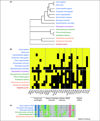Evolutionary origins of STIM1 and STIM2 within ancient Ca2+ signaling systems
- PMID: 21288721
- PMCID: PMC3175768
- DOI: 10.1016/j.tcb.2011.01.002
Evolutionary origins of STIM1 and STIM2 within ancient Ca2+ signaling systems
Abstract
Human stromal interaction molecule (STIM) proteins are parts of elaborate eukaryotic Ca(2+) signaling systems that include numerous plasma membrane (PM), endoplasmic reticulum (ER), and mitochondrial Ca(2+) transporters, channels and regulators. STIM2 and STIM1 function as Ca(2+) sensors with different sensitivities for ER Ca(2+). They translocate to ER-PM junctions and open PM Orai Ca(2+) influx channels when receptor-mediated Ca(2+) release lowers ER Ca(2+) levels. The resulting increase in cytosolic Ca(2+) leads to the activation of numerous Ca(2+) effector proteins that in turn regulate differentiation, cell contraction, secretion and other cell functions. In this review, we use an evolutionary perspective to survey molecular activation mechanisms in the Ca(2+) signaling system, with a particular focus on regulatory motifs and functions of the two STIM proteins. We discuss the presence and absence of STIM genes in different species, the order of appearance of STIM versus Orai, and the evolutionary addition of new signaling domains to STIM proteins.
Copyright © 2011 Elsevier Ltd. All rights reserved.
Figures



References
Publication types
MeSH terms
Substances
Grants and funding
LinkOut - more resources
Full Text Sources
Other Literature Sources
Miscellaneous

